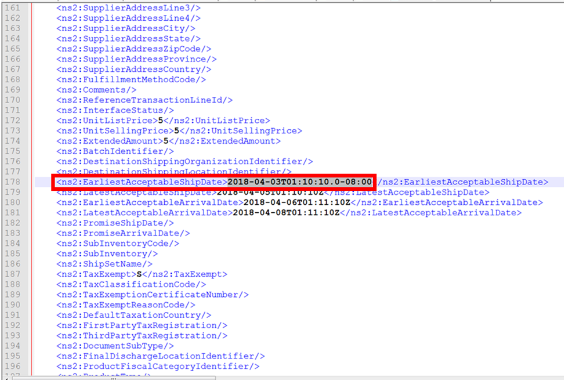Manage Time Zones in Order Management
Oracle Global Order Promising uses the time zone where the inventory organization resides when it calculates promising for the supply that Oracle Order Management needs to fulfill each sales order, then sends the scheduled ship date and scheduled arrival date to Order Management.
Global Order Promising uses date attributes from Order Management to optimize supply, such as Earliest Acceptable Date or Latest Acceptable Date.
Using the time zone where the inventory organization resides provides more accurate values in date attributes, and helps to avoid undesirable time shifts between demand and supply. For example, to prevent the scheduled ship date from happening before the requested date or the ordered date.
-
Order Management applies this behavior for sales orders that you create in the Order Management work area and for source orders that you import order from a source system.
-
This behavior doesn't apply for drop shipments.
Example of Calculating Time Zone Differences
Assume:
-
You're in Denver, Colorado, USA, in Mountain Standard Time (MST), which is UTC-7.
-
The inventory organization also uses UTC-7.
-
The warehouse uses a scheduling calendar that's open Monday through Friday, so Global Order Promising can set the Scheduled Ship Date attribute for the shipment on any weekday, but not on the weekend.
-
The on-hand supply is always available.
For example:
-
You use the Order Management work area to set the requested date on the sales order to 3/2/24 5:00 PM, which is a Friday, then submit the sales order.
-
Order Management interacts with Global Order Promising in UTC (Coordinated Universal Time), so it sends 3/3/24 00:00AM (UTC) as the requested date.
-
Promising converts the requested date to the time zone where the inventory organization resides, which is 3/2/24, Friday, 05:00 PM (UTC-7).
-
Promising schedules the shipment at the inventory organization to the end of the day, which is 3/2/24, 11:59 PM local time (UTC-7), because this day is a working day.
-
Promising sends schedule details to Order Management as Saturday, 3/3/24, 6:59 AM (UTC).
06:59 is a seven hour offset from UTC. The calculation is
Friday, 11:59 PM local time (UTC-7) plus seven hours equals Saturday, 3/3/24 06:59 AM (UTC). -
The Order Management work area now displays the scheduled ship date in UPTZ, which is UTC-7.
The scheduled ship date in UTC was 3/3/18 minus 06:59AM (UTC). The time and date in UPTZ is 3/2/24 minus 11:59 PM (UTC-7).
Promising uses UTC. Order Management displays dates in UPTZ (User Preference Time Zone) so they're meaningful to the person who uses the Order Management work area.
UTC (Coordinated Universal Time) uses this nomenclature:
UTC-x
-means minusx
For example, UTC-7 means UTC minus 7 hours.
Handle Time Zone Differences When You Import Orders
You can use the DooDecompReceiveOrderComposite web service to import a source order from your source system. You use various date attributes in the web service payload, such as requested ship date, requested arrival date, expected arrival date, and so on.
You use the yyyy-mm-ddTHH:mi:ssZ format for each date attribute.
Requirements for how you format dates are different depending on how you import your source order.
|
How You Import |
Description |
|---|---|
|
You use the ReceiveOrder web service. |
Dates in your import payload can use UTC with or without a negative or positive offset. |
|
You use the order import template. For details, see Import Orders Into Order Management. You use the business-to-business flow. For details, see Overview of Business-to-Business Messaging in Order Management. |
Dates in your import payload must use UTC. |
Here's an example payload for the ReceiveOrder web service. It includes a UTC offset for the Earliest Acceptable Ship Date attribute. This value indicates that the end of day is April 3, 2018, and the time is 1:10:10 AM in the time zone that's 8 hours behind UTC.

You must the yyyy-mm-ddThh:mi:ssz format.
where
|
This Variable |
Specifies This Value |
|---|---|
|
yyyy |
Calendar year. |
|
mm |
Month of the calendar year. |
|
dd |
Numeric day of the month. |
|
T |
Time designator. |
|
hh |
Number of hours after midnight, in the 24 hour format. |
|
mi |
Minutes after the beginning of the hour. |
|
ss |
Seconds after the beginning of the minute. |
|
z |
Time zone indicator with or without a UTC offset. For example, 0-8.00 is eight hours behind UTC. |
Consider an example.
2024-04-03T01:10:10.0-08:00
where
|
Value |
Description |
|---|---|
|
2024 |
Calendar year. |
|
04 |
Month of the calendar year, which is April. |
|
03 |
Numeric day of the month, which is April 3rd. |
|
t |
Time designator. |
|
01 |
One hour after midnight. |
|
10 |
Ten minutes after the beginning of the hour. |
|
10 |
Ten seconds after the beginning of the minute. |
|
0-08:00 |
where
|